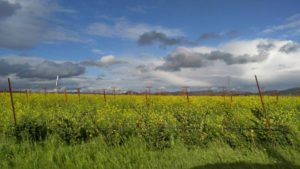My earliest memories of drinking wine are filled with gritty pictures of downtown New York City, in the early to mid-1990s; cheap European libations being consumed over long, in-depth conversations revealing the deepest parts of our youthful souls and venting frustrations about being outcasts in our forsaken homes. At the time, among the artsy, international group, wine from Europe was the only option considered to be a safe buy, to avoid judgment from the other creative intellectuals. Years later, I found the majority of my NYC wine trade experience to revolve around a Eurocentric portfolio of wines, and it only a few years ago, perhaps 4 or 5 to be more precise, that I realized the true wealth of varieties and shear elegance and beauty of California wines when a couple of trendy wine buyers from London educated me about my ignorance of my own country.
Napa Valley
It was only fitting that British wine experts would open my eyes to all that I was not appreciating about my home country with regards to wine. Many of you may know of the famous 1976 Judgment of Paris that was arranged by Steven Spurrier, a British well known great taster, wine expert and former wine merchant in Paris, that unintentionally placed Napa Valley on the international map as a great wine making area. He pitted Napa Wines against some of the greatest French wines in a blind tasting to be judged by eleven judges – nine of them being French wine savvy individuals in the trade, media or education. Two Napa Valley wines won for best red and white… it was the first time that articles written in respectable journals and newspapers considered another country in the same breath as France when it came to quality wine. It was not so much about who was better, but more of a hopeful sign to the US, and especially Napa, that we could hold our heads high with the progress that we had been making in the wine world.
Before that time, wine producers in Napa could not get banks to give them loans, so making quality wine did not have a bright future and really was only taken on by those hopeless dreamers that many thought would eventually end up bankrupt. What would have happened if the Judgment of Paris never happened, or if news of it didn’t leak out to major publications?? We are a country that is a hodgepodge of cultures from around the world, and the fact is that the majority of Americans’ ancestors that arrived during the height of immigration around the turn of the 20th century did not have an impressive pedigree. Often, they were people who were desperate, willing to take a gamble on their lives because the alternative was bleak and dismal… we were not considered a sophisticated, worldly nation that could appreciate premium wine, let alone make it.
Problem with Taking Away One Aspect that makes American Wines Special
For some reason, we are now doing the one thing that our ancestors were trying to escape: placing ourselves in a box. Many of us think that Napa Valley is only ideal for Cabernet Sauvignon and Chardonnay wines because those are the wines that won the Judgment of Paris, that were validated by 10 non-Americans wine experts. Even further is our misconception that all Napa Cabernets and Chardonnay are big, ripe and lush… not that there is anything wrong with that style, but it certainly doesn’t represent all the possibilities of the complex topography of Napa Valley.
White Wines
Back in February, I attended The Symposium for Professional Wine Writers in Napa Valley. I knew I would be drinking lots of great, varied Cabernet Sauvignon (earthy to fruity), as well as delicious Pinot Noir from Carneros, and Chardonnay ranging the gamut from rich and buttery to lean and zesty with a mineral edge… but I didn’t realize I would be the most excited to drink tons of Napa Sauvignon Blanc and other whites such as Riesling, Chenin Blanc, Grenache Blanc, Albariño, Grüner Veltliner and artisanal sparkling. The hosts were generous with the wine selection they constantly offered us during our stay, and although I could have drunk whatever I wanted, it was the plethora of white wine assortments that I ran to each day. And so, recently, I had the Napa Valley Vintners Association send me a sampler of their white wines.
We Need to Validate Ourselves
Re-tasting some of these Napa white wines, as well as discovering some new ones, reconfirmed in me that we have reached a level of expertise and diversity in our wine industry that we can stand behind our own wines…we no longer need approval from those with a longer wine history or culture. I love European wines and I will always love them, but I had allowed my need to escape from my own insecurities to cloud my judgments about my own home, my own history, my own wine culture. I had always fantasized about being part of a multi-generation European family that could trace their people to a specific town that goes back 5 or 6 centuries… but in reality, I am a mutt, a mutt that has no real sense of my ancestors or even traditions to follow. But why does that have to be better or worse? Why can’t we embrace that we, as Americans, often have to make up the rules as we go along, and sometimes that creates something not so great… but sometimes it creates a whole new spectacular, interesting thing that shows the world that your destiny is not always based on your birthright.
“The future belongs to those who believe in the beauty of their dreams.”-Eleanor Roosevelt
****************************************************
Napa Wines Tasted on May 17th, 2017
Napa Valley Sparkling Wine:
 –2012 Frank Family Vineyards Blanc de Blancs, Carneros, Napa Valley: 100% Chardonnay. Wow! This stunning bottle of sparking wine shows the potential elegance and finesse of Carneros sparklers. Many times when people drink California sparkling, they go to one of Champagne’s California outposts, trusting that if a Champagne brand is behind it, then it must be good… but I would like to plead the case for the smaller, California-born producers such as Frank Family if you want to really experience how great California bubbles can be. Intense minerality with lovely white flowers and lime blossom on the long finish. Only 500 cases made.
–2012 Frank Family Vineyards Blanc de Blancs, Carneros, Napa Valley: 100% Chardonnay. Wow! This stunning bottle of sparking wine shows the potential elegance and finesse of Carneros sparklers. Many times when people drink California sparkling, they go to one of Champagne’s California outposts, trusting that if a Champagne brand is behind it, then it must be good… but I would like to plead the case for the smaller, California-born producers such as Frank Family if you want to really experience how great California bubbles can be. Intense minerality with lovely white flowers and lime blossom on the long finish. Only 500 cases made.
A while ago, I worked at one of Manhattan’s top fine wine retailers, and as one can imagine, we sold a lot of famous Napa wines. One customer, who was a die hard Napa Valley Cabernet Sauvignon drinker, talked about how one of the best wines he ever had was from Frank Family. At the time, I had not heard of them, so I was fascinated to try their wines one day. This past February, when I was in Napa, I got the chance to try a bunch of Napa wines blind during a Vintage Perspective Tasting during Premiere Napa Valley. There were a series of producers who were showing their 2012, 2013 and 2014 Cabernet Sauvignon wines blind. Afterwards, I found out Frank Family made my top three… and so I finally got to try them. I was so excited to see this sparkling in my group of samples.
 –2011 Schramsberg Brut, Carneros, Napa Valley: 88% Chardonnay and 12% Pinot Noir. Years ago, someone put me in my place about California sparkling wine being on the same level as top Champagne, using Schramsberg as an example. Any serious traditional sparkling wine enthusiast (who is open to tasting non-Champagne bubbles) I have met knows Schramsberg wines intimately. Delicious brioche, nutty notes with gold apple and a creamy body with a fine bead. Only 1,130 cases made.
–2011 Schramsberg Brut, Carneros, Napa Valley: 88% Chardonnay and 12% Pinot Noir. Years ago, someone put me in my place about California sparkling wine being on the same level as top Champagne, using Schramsberg as an example. Any serious traditional sparkling wine enthusiast (who is open to tasting non-Champagne bubbles) I have met knows Schramsberg wines intimately. Delicious brioche, nutty notes with gold apple and a creamy body with a fine bead. Only 1,130 cases made.
–2013 Schramsberg, Crémant Demi-Sec, Napa Valley: 78% Flora, 13% Pinot Noir and 9% Chardonnay. This was so much fun and truly a unique experience with 78% Flora – a cross of Sémillon and Gewürztraminer developed at UC Davis. Off-dry sparkling with playful flavors of lavender and lemon meringue and a zesty, bright finish. Only 1,991 cases made.
Napa Valley Sauvignon Blanc Wine:
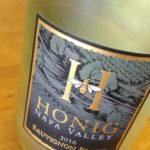 –2016 Honig, Sauvignon Blanc, Napa Valley: 95% Sauvignon Blanc, 4% Sémillon and 1% Muscat. Honig’s Sauvignon Blanc always has a great energy with linear body and mouthwatering acidity. This 2016 is a wonderful example of what one can always expect with their SB, with lemon zest, dried flowers and a stony minerality.
–2016 Honig, Sauvignon Blanc, Napa Valley: 95% Sauvignon Blanc, 4% Sémillon and 1% Muscat. Honig’s Sauvignon Blanc always has a great energy with linear body and mouthwatering acidity. This 2016 is a wonderful example of what one can always expect with their SB, with lemon zest, dried flowers and a stony minerality.
This is the first Napa Valley Sauvignon Blanc I had tried many years ago, and it sells really well here in New York City. The owner, Michael Honig, and his wife Stephanie visit the NYC market often and so they were able to introduce their Sauvignon Blanc personally, which always impresses everyone when they try it… especially considering it is only $15.
 –2016 Turnbull, Sauvignon Blanc, Estate Grown, Oakville, Napa Valley: A seriously rich, textured Sauvignon Blanc that was fermented in terracotta amphora and aged in French Oak and Acacia barrels. It has all the brightness that one would expect with this variety yet it has bountiful exotic fruit such as papaya… besides being texturally seducing, there is also a unique mineral note that takes the form of crumbly calcareous rock.
–2016 Turnbull, Sauvignon Blanc, Estate Grown, Oakville, Napa Valley: A seriously rich, textured Sauvignon Blanc that was fermented in terracotta amphora and aged in French Oak and Acacia barrels. It has all the brightness that one would expect with this variety yet it has bountiful exotic fruit such as papaya… besides being texturally seducing, there is also a unique mineral note that takes the form of crumbly calcareous rock.
Back in November of last year, I was able to hear the winemaker of Turnbull, Peter Heitz, talk at a seminar that highlighted the Oakville AVA in Napa Valley. It was mainly focused on the dominant Cabernet Sauvignon wines of the area, but he did speak about the diversity of the soil, aspect and microclimates that allows for diversity of grape varieties. Turnbull is known for focusing on their vineyards, understanding them, and it was interesting when Peter briefly addressed the idea of climate change. He said that although the research shows some areas are minutely getting warmer, other pockets of Napa are getting cooler. Again, Napa has a complex topography so depending on changes of air flow, more or less fog, or a myriad of other factors, there may be an increase or even decrease in temperature. It is just another reason why they are able to produce an array of grape varieties with proficiency.
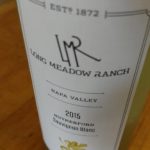 –2015 Long Meadow Ranch, Sauvignon Blanc, Rutherford, Napa Valley: The Sauvignon grapes were harvested at two different times – the first for freshness and acidity, and the second for ripe fruit flavors. A fun, lively wine with lemon drops and apricot preserves with an interesting dusty, sort of volcanic ash note. For those who love the brightness of Sauvignon Blanc, as well as the flavor profile, but find it too lean, or sometimes people say “sour,” I would recommend them to try some of these Napa versions as they will give you more flesh, less severe acidity, wrapped up in all the SB goodness. Screw cap closure.
–2015 Long Meadow Ranch, Sauvignon Blanc, Rutherford, Napa Valley: The Sauvignon grapes were harvested at two different times – the first for freshness and acidity, and the second for ripe fruit flavors. A fun, lively wine with lemon drops and apricot preserves with an interesting dusty, sort of volcanic ash note. For those who love the brightness of Sauvignon Blanc, as well as the flavor profile, but find it too lean, or sometimes people say “sour,” I would recommend them to try some of these Napa versions as they will give you more flesh, less severe acidity, wrapped up in all the SB goodness. Screw cap closure.
 –2015 Provenance Vineyards, Sauvignon Blanc, Rutherford, Napa Valley: Mostly Sauvignon Blanc with a “splash” of Sémillon. I was so happy that I tried all the wines without looking at the alcohol percentages. Most of the Sauvignon Blanc wines are 13 to 13.5% abv, with the exception of the Grgich Hills at around 14% abv, and this one at 14.8% abv. For those who doubt why a Sauvignon Blanc should be close to 15% abv I would ask them to try this wine, or better yet, I would give it to them without them knowing the alcohol. When a wine is in balance it is in balance. I have to guess that they decided not to pick the grapes early to make sure they got full development of the flavors. This wine stood out as being different, with a more honeysuckle, intense floral quality, pineapple fruit with no herbaceousness. It is a different expression of Sauvignon Blanc that is not better or worse but I think it is wonderful that people are exploring different ways to express it. I did not think this wine was too hot… it was still refreshing yet it had a fleshy body that may be preferred by some people. Screw cap closure.
–2015 Provenance Vineyards, Sauvignon Blanc, Rutherford, Napa Valley: Mostly Sauvignon Blanc with a “splash” of Sémillon. I was so happy that I tried all the wines without looking at the alcohol percentages. Most of the Sauvignon Blanc wines are 13 to 13.5% abv, with the exception of the Grgich Hills at around 14% abv, and this one at 14.8% abv. For those who doubt why a Sauvignon Blanc should be close to 15% abv I would ask them to try this wine, or better yet, I would give it to them without them knowing the alcohol. When a wine is in balance it is in balance. I have to guess that they decided not to pick the grapes early to make sure they got full development of the flavors. This wine stood out as being different, with a more honeysuckle, intense floral quality, pineapple fruit with no herbaceousness. It is a different expression of Sauvignon Blanc that is not better or worse but I think it is wonderful that people are exploring different ways to express it. I did not think this wine was too hot… it was still refreshing yet it had a fleshy body that may be preferred by some people. Screw cap closure.
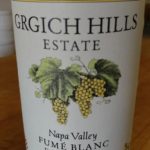 –2014 Grgich Hills, Estate, Fumé Blanc, Dry Sauvignon Blanc, Napa Valley: 100% Sauvignon Blanc. Mike Grgich is a living legend and represents the American dream. Mike was inducted into the Vintners Hall of Fame in 2008 for his achievements. Fumé Blanc is a Sauvignon Blanc that has been fermented and aged in oak and it is synonymous with Napa Valley. Baked apple and melon with a hint of honey and spice with a textural body that can be paired with richer dishes.
–2014 Grgich Hills, Estate, Fumé Blanc, Dry Sauvignon Blanc, Napa Valley: 100% Sauvignon Blanc. Mike Grgich is a living legend and represents the American dream. Mike was inducted into the Vintners Hall of Fame in 2008 for his achievements. Fumé Blanc is a Sauvignon Blanc that has been fermented and aged in oak and it is synonymous with Napa Valley. Baked apple and melon with a hint of honey and spice with a textural body that can be paired with richer dishes.
Napa Valley’s Other Whites Wines:
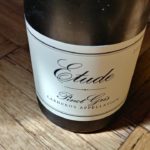 –2015 Etude, Pinot Gris, Carneros, Napa Valley: Majority of their grapes coming from their Estate Vineyard at Grace Benoist Ranch. Their Grace Benoist Ranch Estate vineyard is tucked away in the cooler northwest corner of Carneros. Back in the day, when I used to work for a major wine/spirits distributor in New York City, Etude was one of those wines that sold themselves. Their Pinot Noir wines seemed to always find the balance between having plenty of beautiful fruit while still having restraint and elegance… never too austere, never too fruity. They are able to achieve that same balance with this Pinot Gris with weighty body, peach skin notes while staying bright.
–2015 Etude, Pinot Gris, Carneros, Napa Valley: Majority of their grapes coming from their Estate Vineyard at Grace Benoist Ranch. Their Grace Benoist Ranch Estate vineyard is tucked away in the cooler northwest corner of Carneros. Back in the day, when I used to work for a major wine/spirits distributor in New York City, Etude was one of those wines that sold themselves. Their Pinot Noir wines seemed to always find the balance between having plenty of beautiful fruit while still having restraint and elegance… never too austere, never too fruity. They are able to achieve that same balance with this Pinot Gris with weighty body, peach skin notes while staying bright.
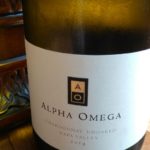 –2014 Alpha Omega, Unoaked Chardonnay, Napa Valley: There was a fine wine retailer in Manhattan that I worked for that afforded the opportunity to taste Napa wines, as well as other top regions of the world, at least a couple times a week. It quickly became clear to me that the old stereotype of big, oaky, buttery Chardonnay did not represent the modern full spectrum of Napa Valley. Many producers pull back on the oak, partially blocking MLF or use malo bugs to avoid buttery notes as a byproduct (sorry for the wine nerd talk) and they pick cooler spots for Chardonnay or may use canopy management to lessen ripeness and to encourage acidity. Here’s another example of a balanced Napa Chardonnay that takes it further without any oak influence. It smelled like an apple orchard with plenty of body yet the finesse of white flowers with chalky minerality was beautifully displayed.
–2014 Alpha Omega, Unoaked Chardonnay, Napa Valley: There was a fine wine retailer in Manhattan that I worked for that afforded the opportunity to taste Napa wines, as well as other top regions of the world, at least a couple times a week. It quickly became clear to me that the old stereotype of big, oaky, buttery Chardonnay did not represent the modern full spectrum of Napa Valley. Many producers pull back on the oak, partially blocking MLF or use malo bugs to avoid buttery notes as a byproduct (sorry for the wine nerd talk) and they pick cooler spots for Chardonnay or may use canopy management to lessen ripeness and to encourage acidity. Here’s another example of a balanced Napa Chardonnay that takes it further without any oak influence. It smelled like an apple orchard with plenty of body yet the finesse of white flowers with chalky minerality was beautifully displayed.
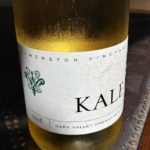 –2016 Kale Somerston Vineyard, Grenache Blanc, Napa Valley: This Grenache Blanc comes from the Priest Ranch Block 6 at 1,250 feet (381 meters) in elevation and is rare to see since only 30 tons of Grenache Blanc are harvested each year in Napa. The grapes see little skin contact with gentle pressing of whole clusters and so the fruit can shine. Juicy nectarine with a hint of white pepper on the flavorful finish. Only 201 cases made.
–2016 Kale Somerston Vineyard, Grenache Blanc, Napa Valley: This Grenache Blanc comes from the Priest Ranch Block 6 at 1,250 feet (381 meters) in elevation and is rare to see since only 30 tons of Grenache Blanc are harvested each year in Napa. The grapes see little skin contact with gentle pressing of whole clusters and so the fruit can shine. Juicy nectarine with a hint of white pepper on the flavorful finish. Only 201 cases made.
 –2016 Lang & Reed, Chenin Blanc, “Oak Knoll District”, Napa Valley: I sort of got a little sad when I saw that this wine came from Chenin Blanc grapes from the cool Oak Knoll District known as one of the very few “remaining stands” of Chenin Blanc, just like the previous Grenache Blanc. It was lovely and interesting, and to think that because we have somehow associated only a couple of varieties with Napa, a lot of fascinating varieties are being pulled out because growers cannot afford to grow them. I love the Loire Valley, and yes, it is the rightful home of Chenin Blanc… but just like all the past immigrants who have come to this country, it is interesting to see how someone, or in this case a variety, can flourish in another environment and the different qualities that can be discovered. Quince paste and lanolin that were illuminated by encompassing acidity. Only 280 cases made.
–2016 Lang & Reed, Chenin Blanc, “Oak Knoll District”, Napa Valley: I sort of got a little sad when I saw that this wine came from Chenin Blanc grapes from the cool Oak Knoll District known as one of the very few “remaining stands” of Chenin Blanc, just like the previous Grenache Blanc. It was lovely and interesting, and to think that because we have somehow associated only a couple of varieties with Napa, a lot of fascinating varieties are being pulled out because growers cannot afford to grow them. I love the Loire Valley, and yes, it is the rightful home of Chenin Blanc… but just like all the past immigrants who have come to this country, it is interesting to see how someone, or in this case a variety, can flourish in another environment and the different qualities that can be discovered. Quince paste and lanolin that were illuminated by encompassing acidity. Only 280 cases made.
 –2015 Galerie Terracea, Riesling, Spring Mountain, Napa Valley: 100% Spring Mountain Riesling. This bottling is a combination of wines that spent some time in concrete egg and new French oak. Kaffir lime leaves, rose petal and acacia flower with a flinty minerality and my mouth watered for several seconds after the finish. Screw cap closure. Only 340 classes made.
–2015 Galerie Terracea, Riesling, Spring Mountain, Napa Valley: 100% Spring Mountain Riesling. This bottling is a combination of wines that spent some time in concrete egg and new French oak. Kaffir lime leaves, rose petal and acacia flower with a flinty minerality and my mouth watered for several seconds after the finish. Screw cap closure. Only 340 classes made.
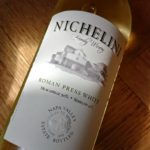 –2015 Nichelini Family Winery, Roman Press White, Napa Valley: 70% Muscadelle and 30% Sémillon. The Muscadelle was planted in 1946 while the Sémillon was planted in 2007. A fun experiment that shows how older and younger vines of complementary grape varieties can enhance the qualities of each other. Orange blossom, marmalade with exotic spice. Only 214 cases made.
–2015 Nichelini Family Winery, Roman Press White, Napa Valley: 70% Muscadelle and 30% Sémillon. The Muscadelle was planted in 1946 while the Sémillon was planted in 2007. A fun experiment that shows how older and younger vines of complementary grape varieties can enhance the qualities of each other. Orange blossom, marmalade with exotic spice. Only 214 cases made.
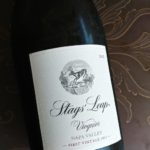 –2015 Stags’ Leap, Viognier, Napa Valley: Stags’ Leap has a long wine history that dates as far back as 1893. Viognier is not an easy variety to deal with and so only those who are truly passionate about it have kept their commitment to making it. This is a graceful expression of the Viognier variety which can have pronounced aromatics and a tendency towards low acidity if not managed correctly. I saved this wine for last because I thought it was going to be a little overbearing, but it was anything but… subtle perfume, meyer lemon and thyme with a full, round body, yet it had a bright lift on the finish and never lacked acidity or freshness.
–2015 Stags’ Leap, Viognier, Napa Valley: Stags’ Leap has a long wine history that dates as far back as 1893. Viognier is not an easy variety to deal with and so only those who are truly passionate about it have kept their commitment to making it. This is a graceful expression of the Viognier variety which can have pronounced aromatics and a tendency towards low acidity if not managed correctly. I saved this wine for last because I thought it was going to be a little overbearing, but it was anything but… subtle perfume, meyer lemon and thyme with a full, round body, yet it had a bright lift on the finish and never lacked acidity or freshness.


